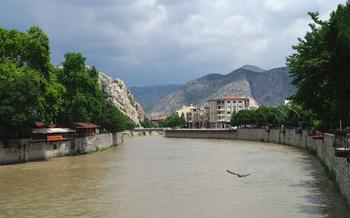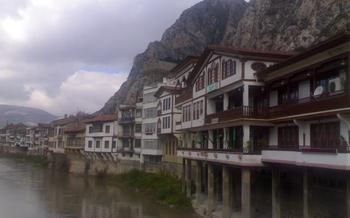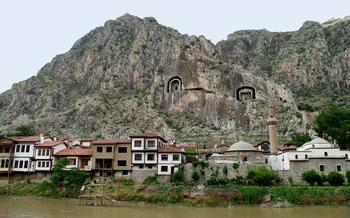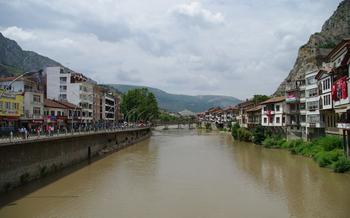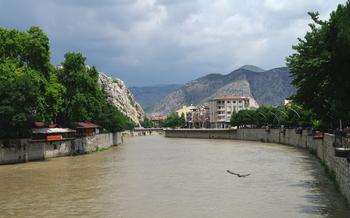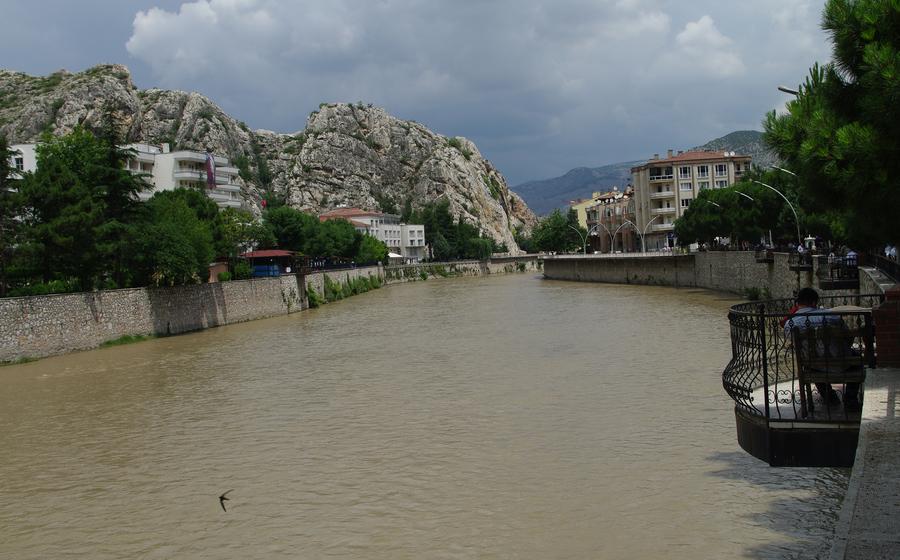
Amasya Tarihi Darphane (Mint)
- History of the Amasya Tarihi Darphane (Mint)
- Location: Finding the Hidden Gem in Amasya
- Unveiling the Mint's Architectural Marvels
- A Journey Through Time: The Mint's Historical Significance
- Exploring the Mint's Exhibitions and Displays
- A Glimpse into the Minting Process
- Amasya Tarihi Darphane: A Symbol of Resilience
- Beyond the Mint: Discovering Amasya's Culinary Delights
- Amasya's Vibrant Cultural Scene
- Exploring Amasya's Natural Wonders
- Majestic Mountains and Panoramic Views
- Serene Waters of the Yeşilırmak River
- Parks and Gardens: A Haven for Relaxation
- Picnics and Camping: Embracing the Outdoors
- Amasya for History Buffs: Must-See Sites
- Accommodation Options for Every Traveler
- Insider Tip: Unveiling Hidden Treasures
History of the Amasya Tarihi Darphane (Mint)
The Amasya Tarihi Darphane, or Amasya Mint, is a testament to the rich history and cultural heritage of the Ottoman Empire. Established in the 16th century during the reign of Sultan Selim II, the mint played a crucial role in the financial and economic development of the empire. It operated continuously for over four centuries, minting coins that circulated throughout the vast Ottoman domains.
The mint's strategic location in Amasya, a major trade and transportation hub in Anatolia, allowed for easy access to precious metals and other resources necessary for minting coins. The city's proximity to the Black Sea also facilitated trade with other regions, further contributing to the mint's importance.
The architectural elegance of the mint reflects the grandeur and power of the Ottoman Empire. Constructed using locally sourced materials, the mint features intricate stone carvings, graceful arches, and a spacious courtyard. Its design incorporates elements of traditional Turkish architecture, creating a harmonious blend of functionality and aesthetics.
During the Ottoman period, the Amasya Mint was one of the largest and most important mints in the empire. It produced a wide variety of coins, including gold, silver, and copper denominations. The mint's coins were used for both domestic and international trade, contributing to the economic stability and prosperity of the empire.
Today, the Amasya Tarihi Darphane stands as a symbol of the Ottoman Empire's legacy. It has been meticulously restored and transformed into a museum, offering visitors a glimpse into the history and significance of the mint. Through interactive exhibits and displays, visitors can learn about the minting process, the different types of coins produced, and the role of the mint in the development of Amasya and the Ottoman Empire.
Location: Finding the Hidden Gem in Amasya
The Amasya Tarihi Darphane is nestled in the heart of the historic Amasya city, a picturesque destination renowned for its stunning natural landscapes and rich cultural heritage. To reach this hidden gem, visitors can take advantage of the city's efficient public transportation system. Buses and taxis readily ply the routes, making it a convenient and cost-effective option.
Upon arrival at the mint, visitors are greeted by a sight that transports them back in time. The mint's unassuming façade, a testament to its humble beginnings, belies the wealth of history and craftsmanship held within its walls. The surrounding area brims with charm, as narrow cobblestone streets wind their way past traditional Ottoman houses and quaint shops, inviting visitors to explore the city's vibrant tapestry of cultures.
Amasya Tarihi Darphane offers a captivating journey into the past, where visitors can trace the footsteps of skilled craftsmen and delve into the intricate processes that shaped the Ottoman Empire's financial system. The mint's proximity to other notable landmarks, such as the Amasya Castle and the Great Mosque, makes it an ideal starting point for a comprehensive exploration of this captivating city.
Unveiling the Mint's Architectural Marvels
The Amasya Tarihi Darphane stands as a testament to the architectural prowess of the Ottoman Empire. Its unique features set it apart from other mints in Turkey and showcase the creativity and skill of its builders.
One striking aspect of the mint's architecture is its impressive fortified walls, which served as a protective barrier against potential threats. These walls, adorned with intricate carvings and decorative elements, exhibit both functionality and aesthetic appeal.
Another notable feature of the mint is its spacious courtyard, which once served as the bustling center of coin production. Surrounded by tall arches and columns, the courtyard provided a well-lit and airy workspace for the mint workers.
The mint's interior chambers are equally impressive, featuring intricate stone carvings, decorative tiles, and vaulted ceilings. These chambers served various purposes, from coin storage and administration to metalworking and minting operations.
The choice of materials used in the construction of the mint further underscores its significance. The solid stone walls, sturdy wooden beams, and hand-painted tiles not only ensured durability but also reflected the mint's status as a vital institution within the Ottoman Empire.
In comparison to other historical mints in Turkey, the Amasya Tarihi Darphane stands out for its well-preserved condition and unique architectural features. While other mints may boast grander dimensions or ornate decorations, the Amasya mint retains its original charm and authenticity, offering a glimpse into the rich history of coin production in the region.
A Journey Through Time: The Mint's Historical Significance
In the heart of the Ottoman Empire, Amasya Tarihi Darphane played a crucial role in shaping the economy and solidifying the empire's financial strength. Established in the 16th century, during the reign of Sultan Süleyman the Magnificent, the mint became a pivotal center for the production of coins, the lifeblood of any thriving empire.
The mint's strategic location in Amasya, a major trade hub and administrative center, facilitated the efficient distribution of coins throughout the empire. Skilled mint workers, employing time-honored techniques, meticulously crafted coins of various denominations, from gold to silver and copper.
The mint's operations were intricately intertwined with the Ottoman Empire's economic policies and fiscal management. It served as a central treasury, where precious metals were stored and safeguarded, ensuring the stability of the empire's currency.
Beyond its economic significance, the mint also played a vital role in the development of Amasya. The influx of mint workers and the associated trade activities stimulated the local economy, creating employment opportunities and fostering the growth of supporting industries.
Exploring the Mint's Exhibitions and Displays
The Amasya Tarihi Darphane houses a captivating collection of artifacts and exhibits that provide a glimpse into the mint's rich history and the art of coin production. The permanent exhibition showcases a variety of coins minted in Amasya during the Ottoman period, including gold, silver, and copper coins. Visitors can marvel at the intricate designs and inscriptions on these coins, which often feature symbols of the Ottoman Empire and the sultans who issued them.
Temporary exhibitions and special events are also held at the mint, showcasing the latest research and discoveries related to coinage and monetary history. These exhibitions often feature coins from other historical periods and regions, allowing visitors to compare and contrast different minting techniques and artistic styles.
Interactive exhibits and educational programs are offered at the mint to enhance visitors' understanding of the minting process and its significance. These exhibits include hands-on activities that allow visitors to try their hand at coin minting and learn about the different steps involved in the process. The mint also offers guided tours and educational programs for groups and schools, providing a deeper dive into the history and operation of the mint.
The Amasya Tarihi Darphane is committed to making its exhibitions and programs accessible to visitors of all abilities. The museum is wheelchair accessible, and audio guides are available for visitors who are deaf or hard of hearing. The mint also offers sign language interpretation for guided tours upon request.
A Glimpse into the Minting Process
Visitors to the Amasya Tarihi Darphane are treated to a fascinating display of the traditional minting process. Skilled artisans demonstrate the intricate steps involved in transforming precious metals into beautiful and valuable coins. Using ancient techniques passed down through generations, these dedicated craftspeople showcase the artistry and precision that goes into each coin.
The demonstration begins with the preparation of the metal, which is carefully melted and poured into molds to create round blanks. These blanks are then meticulously trimmed and weighed to ensure they meet the exact specifications. Once the blanks are ready, they are placed in a coining press, where they are struck with a pair of dies bearing the desired design. The force of the press imprints the design onto the blank, creating a raised relief on one side and a recessed intaglio on the other.
The newly minted coins are then inspected for quality and sorted according to their weight and appearance. Coins that meet the required standards are polished and packaged, while those that do not are melted down and reused. Visitors can also witness the intricate process of creating the dies used in the minting process, which involves engraving the desired design onto a steel block using specialized tools and techniques.
This demonstration provides a unique opportunity to witness firsthand the skill and artistry involved in the production of coins. It offers visitors a deeper appreciation for the historical significance of the Amasya Tarihi Darphane and the important role it played in the Ottoman Empire's economy.
Amasya Tarihi Darphane: A Symbol of Resilience
The Amasya Tarihi Darphane has stood the test of time, enduring various historical events and upheavals. Despite facing challenges and periods of decline, the mint has managed to survive and retain its significance. Its resilience is a testament to the importance it held in the Ottoman Empire and the value it continues to have as a cultural and historical monument.
The mint's survival is attributed to several factors. Firstly, its strategic location in Amasya, a city with a rich history and cultural heritage, has contributed to its preservation. Additionally, the mint's solid construction and the use of durable materials have enabled it to withstand the ravages of time and natural disasters.
Furthermore, the mint's significance as a symbol of Ottoman heritage has played a crucial role in its preservation. The Turkish government and local authorities have recognized the mint's historical and cultural value, leading to efforts to restore and maintain the structure. These efforts have ensured that the mint remains a well-preserved example of Ottoman architecture and a source of pride for the Turkish people.
In recognition of its historical significance and resilience, the Amasya Tarihi Darphane has received numerous awards and accolades. These include being designated as a UNESCO World Heritage Site, a testament to its global importance and cultural significance. The mint's recognition as a valuable historical monument has further contributed to its preservation and protection.
Beyond the Mint: Discovering Amasya's Culinary Delights
A visit to the Amasya Tarihi Darphane is not complete without sampling the city's mouthwatering cuisine. Amasya boasts a rich culinary heritage, influenced by its diverse history and geographical location. From traditional Turkish dishes to unique regional specialties, there's something to satisfy every palate.
One must-try dish is the famous Amasya kebab, a succulent skewer of marinated lamb grilled to perfection. The Amasya çorbası, a hearty and flavorful soup made with lamb, vegetables, and yogurt, is another local favorite. For a sweet treat, indulge in the Amasya helvası, a delicious dessert made from sesame seeds, sugar, and butter.
To experience the authentic flavors of Amasya, venture into the city's vibrant streets and explore the local markets and restaurants. Amasya Pazarı, the city's main market, is a bustling hub of activity where you can find fresh produce, spices, and traditional Turkish delicacies.
For a memorable dining experience, try one of the many restaurants near the mint. Sultan Sofrası offers a delightful array of traditional Turkish dishes, while Kebapçı Mustafa is renowned for its succulent kebabs. For a taste of local cuisine in a charming setting, head to Hanımeli Konağı, a traditional Ottoman mansion transformed into a restaurant.
Amasya's culinary scene is not just about traditional Turkish fare. The city is also home to several international restaurants, offering a diverse range of cuisines from around the world. Whether you're craving Italian pasta, Indian curry, or Chinese stir-fry, you'll find it in Amasya.
To fully immerse yourself in the local culture, take part in a cooking class and learn how to prepare traditional Amasya dishes. Several cooking schools in the city offer classes for visitors of all skill levels, providing a hands-on experience and a deeper understanding of Turkish cuisine.
No matter your taste or budget, Amasya has something to offer every foodie. From street food stalls to fine-dining restaurants, the city's culinary scene is sure to tantalize your taste buds and leave you craving for more.
Amasya's Vibrant Cultural Scene
Amasya's rich history and diverse cultural influences have given rise to a vibrant cultural scene that captivates visitors from all walks of life. Explore the city's traditional arts and crafts, indulge in its delectable cuisine, immerse yourself in its lively festivals and events, and connect with the friendly locals who are always ready to share their stories and traditions.
Traditional Music and Dance Performances
Amasya's cultural heritage comes alive through its mesmerizing traditional music and dance performances. Experience the soulful melodies of Turkish folk music, accompanied by the rhythmic beats of drums and traditional instruments like the bağlama (saz). Witness the graceful movements of Turkish folk dances, such as the zeybek and halay, performed by skilled dancers adorned in colorful costumes.
Local Crafts and Souvenirs
Discover the artistry of Amasya's local craftsmen and women, who create beautiful handmade souvenirs and crafts that reflect the city's unique heritage. From intricate carpets and kilims to hand-painted ceramics and jewelry, there's something for every taste and budget. Take home a piece of Amasya to cherish and remember your visit.
Festivals and Events
Throughout the year, Amasya hosts a variety of festivals and events that celebrate its culture, history, and traditions. Experience the excitement of the annual Amasya Cherry Festival, where you can indulge in delicious cherry-based dishes, witness traditional cherry-picking competitions, and enjoy live music and performances. Other notable events include the Amasya International Art Festival, showcasing the works of local and international artists, and the Amasya Music Festival, featuring renowned musicians from around the world.
Opportunities for Cultural Exchange with Locals
Amasya's friendly locals are passionate about sharing their culture and traditions with visitors. Engage in conversations with them, learn about their way of life, and immerse yourself in the true essence of Turkish hospitality. Visit local teahouses, markets, and workshops to interact with the locals and gain a deeper understanding of their customs and beliefs.
Exploring Amasya's Natural Wonders
Beyond its rich history and cultural heritage, Amasya boasts breathtaking natural landscapes that offer a refreshing contrast to the city's urban charm. Just a stone's throw from the Amasya Tarihi Darphane, visitors can immerse themselves in the tranquility of nature and discover hidden gems that showcase the region's diverse ecosystems.
Majestic Mountains and Panoramic Views
The mountainous terrain surrounding Amasya provides ample opportunities for hiking enthusiasts and nature lovers. The Aladağlar Mountains, with their imposing peaks and lush forests, offer challenging trails for experienced hikers. Summiting these peaks rewards adventurers with awe-inspiring panoramic views of the city and the surrounding countryside.
Serene Waters of the Yeşilırmak River
The Yeşilırmak River, a lifeline for Amasya, meanders through the city, creating a tranquil oasis amidst the urban hustle and bustle. Visitors can embark on scenic boat tours that offer unique perspectives of the city's landmarks and natural beauty. The river also beckons water sports enthusiasts, with opportunities for kayaking, canoeing, and fishing.
Parks and Gardens: A Haven for Relaxation
Amasya is home to several parks and gardens that offer respite from the summer heat and provide tranquil spaces for relaxation and contemplation. The Amasya Botanical Garden showcases a diverse collection of plant species from around the world, while the Şehzadeler Parkı offers a serene setting with manicured lawns, flower beds, and a picturesque lake.
Picnics and Camping: Embracing the Outdoors
For those seeking a truly immersive experience, Amasya offers numerous designated picnic spots and camping grounds located near natural attractions. Pack a basket of local delicacies and enjoy a leisurely picnic surrounded by stunning scenery. Embrace the tranquility of the outdoors by camping under the stars, waking up to the sound of birdsong and the gentle flow of the river.
Amasya for History Buffs: Must-See Sites
Amasya is a treasure trove for history enthusiasts, with a wealth of historical sites and landmarks that tell the story of its rich past. Beyond the mint, here are some must-see sites that offer a glimpse into different eras and civilizations:
-
Amasya Castle: Perched atop a hill overlooking the city, this majestic castle dates back to the Hittites and has seen many empires come and go. Explore its imposing walls, towers, and dungeons to unravel the secrets of its storied past.
-
Sultan Bayezid II Mosque: This architectural masterpiece, built by the Ottoman Sultan Bayezid II in the 15th century, features stunning tilework, intricate carvings, and a unique octagonal design. Admire its beauty and learn about its significance in the city's Islamic heritage.
-
Rock Tombs: Scattered throughout the city, these ancient rock-cut tombs date back to the Hellenistic period. Marvel at their intricate facades and inscriptions, offering a glimpse into the lives and beliefs of Amasya's earliest inhabitants.
-
Harşena: Located just outside the city, this ancient city was once the capital of the Pontic Kingdom. Explore its impressive ruins, including the theater, temple, and fortifications, and immerse yourself in the history of this once-thriving metropolis.
-
Gökmedrese: This 13th-century theological school is one of the oldest and most well-preserved in Turkey. Admire its stunning Seljuk architecture, intricate tilework, and peaceful courtyard, and learn about its role in Islamic education and scholarship.
Accommodation Options for Every Traveler
Amasya offers a diverse range of accommodation options to cater to every traveler's needs and budget. Whether you seek luxury, comfort, or affordability, you'll find suitable lodging in this historic city.
For those seeking a luxurious stay, the Grand Otel Amasya offers elegant rooms and suites with stunning views of the city. The hotel features a spa, a fitness center, and several dining options.
If you prefer a more intimate experience, consider Konak Oteli. Located in a charming Ottoman-era mansion, this boutique hotel offers cozy rooms with traditional Turkish decor.
Budget travelers will find several affordable options in Amasya. The Amasya Youth Hostel provides basic but comfortable accommodations in a social setting.
Recommended places to stay near the mint: * Amasya Mint Hotel: Located just steps from the mint, this hotel offers convenient and comfortable accommodations. * Tarihi Konak Oteli: This charming hotel is housed in a restored Ottoman mansion and offers a unique and authentic experience.
Tips for finding budget-friendly accommodation: * Book in advance, especially during peak season, to secure the best rates. * Consider staying in a hostel or guesthouse for a more affordable option. * Look for discounts and special offers on travel websites and booking platforms. * Ask for recommendations from locals or fellow travelers for hidden gems and budget-friendly options.
Booking in advance during peak season: Amasya is a popular tourist destination, and accommodation prices can be higher during peak season (summer and holidays). To avoid disappointment and secure your preferred accommodation, it's advisable to book in advance, especially if you have specific requirements or are traveling in a group.
Insider Tip: Unveiling Hidden Treasures
Beyond the popular tourist attractions, Amasya conceals a wealth of hidden treasures waiting to be discovered. Explore the old city's narrow, winding streets to uncover charming cafes, unique shops, and hidden courtyards. For a breathtaking perspective, climb to the ruins of the Amasya Kalesi (Amasya Castle) for panoramic views of the city and the surrounding countryside.
Seek out the lesser-known historical sites, such as the Gökmedrese (Blue Madrasah), with its stunning blue tiles and intricate carvings, or the Burmalı Minare Camii (Twisted Minaret Mosque), known for its unique spiral minaret. These hidden gems offer a glimpse into Amasya's rich history and culture.
To savor authentic local flavors, venture into the side streets and discover small, family-run restaurants that serve delicious traditional dishes. Engage with the friendly locals, who are always eager to share stories about their city and recommend hidden spots.
Embrace the opportunity to explore Amasya like a local, immersing yourself in its vibrant culture and uncovering its hidden treasures. With an open mind and a sense of adventure, you'll find that the true essence of Amasya lies beyond the beaten path.
